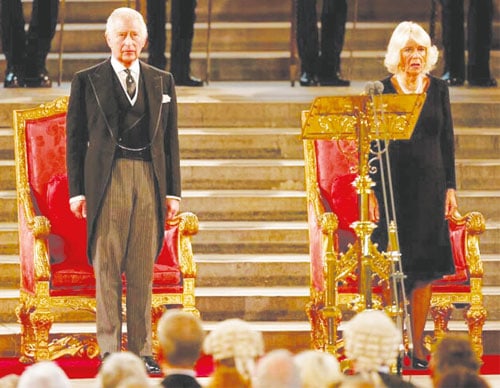Pledges to follow late Queen Elizabeth’s example
King Charles called Britain’s parliament the “living and breathing instrument of our democracy” and pledged to follow his late mother Queen Elizabeth’s example in maintaining its independence in an address to both chambers on Monday.
Charles arrived at Westminster Hall in London to a fanfare of trumpets with his wife Camilla, Queen Consort, for the address — part of a series of pageantry-filled ceremonies following the queen’s death on Thursday at her holiday home in Balmoral, Scotland, after 70 years on the throne.
After the address, the new monarch set out for Edinburgh to join his siblings for a solemn procession when the coffin of Queen Elizabeth is taken to the city’s historic cathedral.
They will then take part in a vigil at St Giles’ Cathedral, on the Scottish capital’s centuries-old Royal Mile, where the coffin will lie at rest before being flown to London on Tuesday.
Prime Minister Liz Truss — still in her first week in office — and parliamentarians from the House of Commons and the House of Lords — attended the address in Westminster Hall.
The Lord speaker described the late queen as “both a leader to and servant of her people”.
Charles and Camilla sat on ceremonial chairs, with cavalry troopers in red tunics and plumed helmets standing to attention behind.
In his address, Charles said: “While very young, Her late majesty pledged herself to serve her country and her people and to maintain the precious principles of constitutional government which lie at the heart of our nation. This vow she kept with unsurpassed devotion.
“She set an example of selfless duty which, with God’s help and your counsels, I am resolved faithfully to follow.” The assembly sang “God Save the King”.
Charles, 73, who automatically became king of the United Kingdom and 14 other realms including Australia, Canada, Jamaica, New Zealand and Papua New Guinea on his mother’s death, is known for expressing his views on matters ranging from the environment to youth issues.
He has suggested that as king, he might have to moderate his style, in keeping with the tradition that the monarch keeps out of political matters.
On Sunday, the queen’s oak coffin, draped in the Royal Standard of Scotland, was taken by hearse on a six-hour journey from Balmoral through picturesque Scottish countryside, villages, small towns and cities to Edinburgh.
Tens of thousands of well-wishers lined the roads to pay their respects, while huge crowds, some in tears, gathered in Edinburgh to greet the cortege.
“I think when the queen’s coffin emerged from Balmoral Castle yesterday, I think that it was a moment of enormous significance,” John Swinney, Scotland’s Deputy First Minister told BBC radio.
“I think people drew breath, because what we’ve all been living through over the last few days suddenly became real, it became visible.”—Agencies










